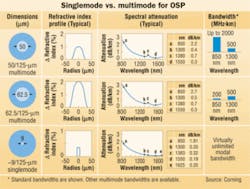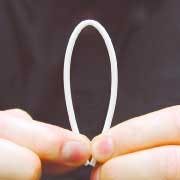With its bandwidth capabilities and recent innovations, OSP singlemode fiber on campus is getting a second look.
In customer-owned campus applications, outside plant-grade (OSP) cable creates the backbone for connecting buildings. As part of that backbone, singlemode fiber is chosen for its distance, bandwidth, and/or futureproofing capabilities.
On campuses with distances of less than 500 meters, most singlemode fiber is left dark for future use. But if bandwidth requirements increase, and campuses spread out, designers and end users may want to give singlemode a second look. Several innovations have expanded singlemode’s capabilities and ease of use in the outside-plant environment, and knowing the features and benefits of today’s OSP singlemode optical-fiber cable can help your customers make informed decisions. (See table of singlemode products, pages 44 and 45.)
Paying for performance
“The main difference between singlemode and multimode is just as the name denotes,” says Phillip Bell, global product line manager for Corning. “Singlemode supports one mode of transmission while multimode supports many-in the hundreds. This is the biggest factor in the performance of singlemode over multimode.”
“With only one mode of transmission, singlemode experiences no intermodal dispersion,” explains Bell. Intermodal dispersion occurs with multimode fiber because various modes of light enter the fiber at one time and exit at different times. The core of a singlemode fiber, at about 9 microns (µm), is much smaller than the 62.5-µm or 50-µm core of multimode, so that light can only travel on a single path. This maintains the integrity of each light pulse, increasing the bandwidth of singlemode to almost infinity.
Recent studies show that 62.5-µm multimode fiber has a bandwidth of 200 MHz.km at the 850-nm wavelength, and 500 MHz.km at the 1300-nm wavelength. Some manufacturers of high-performance, laser-optimized 50-µm multimode fiber claim a bandwidth potential of up to 2000 MHz.km.
Laser-optimized multimode fiber has been the fiber of choice for today’s OSP campus applications. Compared to multimode fiber, however, singlemode can go much longer distances at very high speeds, making it the de facto cable for public long-haul applications. But even if customer-owned campuses expand to include distances in excess of 500 to 1000 meters, or if bandwidth requirements increase to 10 Gigabit or higher in the backbone, singlemode still deserves a hard look.
“When we look at high schools, police departments, and most businesses in a campus setting, multimode will provide enough bandwidth for quite some time,” says Paul Neveux, PhD, director of product management for premises cable, Superior Essex. “But campuses that are extremely large and have heavy computing requirements between buildings may require a singlemode system.”
Installing an OSP singlemode system, however, can be costly. “You’re dealing with connections and electronics that are inherently a more expensive solution, and that’s why laser-optimized multimode entered the market,” says Mike Barnick, senior manager of solutions marketing at SYSTIMAX. “To launch a laser into the smaller core of singlemode fiber, the tolerances have to be extremely sharp, and that brings a much higher price tag.”
Defining the designs
Several OSP singlemode fiber designs are available, with various buffering and cable types:
• Tight-buffered cables, deployed in indoor and outdoor campus applications, are easy to connectorize. “Tight-buffered designs use a color-coded compound like PVC applied directly to the fiber itself,” explains John Armistead, director of product management for OSP fiber, Superior Essex. “For tight-buffered cables to be utilized in the outside plant, they must meet certain water blocking and temperature criteria.”
• Loose-tube singlemode cable is primarily an OSP cable consisting of a group of fibers color-coded for identification. The fibers are fitted inside a tube with gel that lets the fibers “float” independently of the cable. “The gel in loose-tube cable protects the fibers when the cable expands or shrinks due to temperature changes,” says Armistead.
• Singlemode ribbon cable consists of colored fibers inside a tight matrix and is characterized by high fiber counts for increased density. “Singlemode ribbon cable allows 12 fibers to be spliced at a time for labor savings in high-fiber count applications,” explains Armistead.
• Flexible dielectric cable is typically deployed in campus applications via a conduit system while single- and double-armored cables are direct buried. “Armored cable prevents rodents from gnawing through the cable, and it offers protection from crushing in rocky environments,” explains Armistead. “The metallic components in armored cable also allows the cable to be located, which is a benefit for customers.” Double-armored cables are less common than single, but are still deployed in the Midwest where larger rodents like gophers are common.
•Indoor/outdoor cables are designed with jacketing materials that let the cable transition from the inside to the outside, saving cost by eliminating the need to splice. “Historically, OSP cable had a black polyethylene jacket that held up well underground but burned like a roman candle; [and] any cable that came into a building couldn’t go more than 50 feet before it needed to be spliced,” explains Barnick. “But we’ve spent a lot of time improving and balancing the jacketing compounds to be suitable for both indoor and outdoor, and the singlemode cable can now come into the building and go up the riser to a main distribution frame.”
Innovations of interest
Recent innovations to OSP singlemode cable are aimed at increasing bandwidth capabilities and easing installation. Zero water peak singlemode fiber, invented by OFS, is available from many fiber vendors and offers increased bandwidth capabilities. The water peak in singlemode fiber, which is created by hydrogen being trapped at defects in the fiber, causes attenuation at certain wavelengths. Zero water peak fiber improves the attenuation performance by removing the water peak in the 1360 to 1460-nm wavelength range, known as the e-band transmission window.
“Our TeraSPEED zero water peak singlemode fiber opens up the e-band window to provide customers with a full spectrum fiber solution by enabling coarse wavelength division multiplexing and providing extra bandwidth at certain wavelengths within the e-band,” says Barnick. Course wavelength division multiplexing (CWDM) combines signals from multiple sources onto a single fiber, allowing for up to 18 wavelengths to be sent. While CWDM is still in development, zero water peak fiber is the singlemode fiber of choice among early adopters for its futureproofing capabilities.
“The key is that zero water peak allows end users to upgrade their systems with WDM equipment in the future,” says Barnick.
Another significant innovation in OSP singlemode fiber is the introduction of the dry water-blocking method that removes the cable’s sticky flooding compound and replaces it with super-absorbent polymers that swell up to stop the ingress of water. “The old flooding compound was not craft friendly-it stuck to everything and cost in labor to clean it up,” says Armistead. “The new polymers make cables lighter, less expensive, and less labor intensive. It’s about 95% of what’s sold today.”
Superior Essex recently introduced its Enhanced Loose Tube with PFM gel, which improves the gel-filling compound used to protect fibers and lets them float independently of the cable. “One of the major benefits of our Enhanced Loose Tube fiber cables is the reduction of friction between the fibers and the buffer tube,” says Armistead. “The tubes are more flexible without compromising durability, reducing the labor costs associated with accessing the fibers and making them ideal for today’s small fiber-to-the-premise enclosures.”
According to Superior Essex, case studies depicting Enhanced Loose Tube fiber use indicate a savings of about 5%.
While singlemode fiber’s performance benefits are recognized, the high cost of a singlemode system hinders it from being used in most customer-owned OSP campus applications.
“With singlemode, you’re dealing with connections and electronics that are inherently a more expensive solution,” says Barnick. “To launch a laser into the smaller core of singlemode fiber, the tolerances have to be extremely sharp, and that brings a much higher price tag.”
Take on tomorrow
Barnick adds, however, that “When we get to 10 Gigabit in the campus backbone, legacy 62.5-µm can only go 32 meters and legacy 50-µm can only handle 82 meters. So, at 10 Gigabit, the only game in town is laser-optimized multimode or singlemode.”
According to Barnick, implementing singlemode for future use is a prudent move. “If I’m pulling in laser-optimized multimode, it’s best to throw in singlemode fibers and leave them dark for futureproofing and peace of mind,” says Barnick. “If there’s a break in technology down the road, or an increase in distance and bandwidth requirements on campus, the singlemode will be there without the cost to retrench.”
Long-range 1310-nm Vertical Cavity Surface Emitting Lasers (VCSELs) have progressed over the past five years and may compete with more expensive Fabry-Perot and distributed feedback (DFB) lasers. (See “Long-range VCSELs take aim at putting zap into structured cabling,” page 26.) There’s hope that the price of singlemode fiber links will decrease enough to impact the market, but some industry professionals disagree.
“Long-wavelength VCSELs will have more of an affect in long-haul public networks, where singlemode remains commonplace,” says Neveux of Superior Essex. “In the campus environment, customers want to look at fiber like they do copper, where they can install it, leave it, and not have to babysit it.”
Neveux adds that “while 1310 VCSELs may help reduce the cost of singlemode systems, it will not be enough to make a switch from multimode in most outside-plant campus applications.”
Click here to download table of singlemode products.
BETSY ZIOBRON is a freelance writer covering the cabling industry, and a regular contributor to Cabling Installation & Maintenance.




